- Clone
- 6B8B69 (See other available formats)
- Regulatory Status
- RUO
- Other Names
- P44/42 MAP (motogen activated protein) Kinase, Extracelluar signal-regulated kinase (ERK)
- Isotype
- Mouse IgG2a, κ
- Ave. Rating
- Submit a Review
- Product Citations
- publications
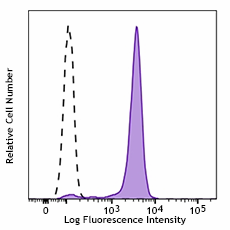
-

Human peripheral blood lymphocytes were stimulated with (filled histogram) or without (open histogram) Cell Activation Cocktail (without Brefeldin A, Cat. No. 423301) for 15 minutes, then fixed with Fixation Buffer (Cat. No. 420801), permeabilized with cold True-Phos™ Perm Buffer (Cat. No. 425401), and intracellularly stained with ERK1/2 Phospho (Thr202/Tyr204) (clone 6B8B69) FITC.
| Cat # | Size | Price | Quantity Check Availability | Save | ||
|---|---|---|---|---|---|---|
| 369519 | 25 tests | 109€ | ||||
| 369520 | 100 tests | 268€ | ||||
ERK1/2 are members of mitogen-activated kinases (MAPKs) of serine/threonine protein kinases. ERK1/2 can be activated by a range of extracellular stimuli, such as mitogen, growth factors, neurotransmitters, chemokines, and cytokines, through receptor tyrosine kinases (RTK), G protein-coupled receptors (GPCRs), or protein kinase C (PKC). Upon stimulation, ERK1/2 are phosphorylated by the upstream kinase MEK on residues Thr202 and Tyr204 and in turn phosphorylate many other downstream molecules that are involved in a range of cellular processes such as cell proliferation, differentiation, motility and cell death.
Product DetailsProduct Details
- Verified Reactivity
- Human, Mouse
- Antibody Type
- Monoclonal
- Host Species
- Mouse
- Immunogen
- Synthetic peptide (TGFLT*EY*VATRC) conjugated to KLH.
- Formulation
- Phosphate-buffered solution, pH 7.2, containing 0.09% sodium azide and BSA (origin USA)
- Preparation
- The antibody was purified by affinity chromatography and conjugated with FITC under optimal conditions.
- Concentration
- Lot-specific (to obtain lot-specific concentration and expiration, please enter the lot number in our Certificate of Analysis online tool.)
- Storage & Handling
- The antibody solution should be stored undiluted between 2°C and 8°C, and protected from prolonged exposure to light. Do not freeze.
- Application
-
ICFC - Quality tested
- Recommended Usage
-
Each lot of this antibody is quality control tested by intracellular flow cytometry using our True-Phos™ Perm Buffer in Cell Suspensions Protocol. For flow cytometric staining, the suggested use of this reagent is 5 µl per million cells in 100 µl staining volume or 5 µl per 100 µl of whole blood.
- Excitation Laser
-
Blue Laser (488 nm)
- Application Notes
-
Clone 6B8B69 was found to strongly cross-react with mouse ERK1/2 Phospho (Thr202/Tyr204) when tested in-house on C57BL/6 mouse splenocytes.
- RRID
-
AB_2721567 (BioLegend Cat. No. 369519)
AB_2721568 (BioLegend Cat. No. 369520)
Antigen Details
- Structure
- ERK1 and ERK2 encode 42 and 44 kD protein kinases and share 85% homology.
- Distribution
-
Cytoplasm and the nucleus.
- Function
- ERK1/2 are broadly expressed protein kinases that are involved in proliferation, differentiation, motility, and cell death. In response to extracellular stimuli, ERK1 and ERK2 are phosphorylated at Thr202 and Tyr204; and in turn transduce signals to downstream substrates.
- Interaction
- ERK1/2 phosphorylates a wide range of downstream substrates, such as ATF2, BCL6, EIF4EBP1, CANX, MAP2, DAPK1, RAF1, SYK, and GRB10.
- Cell Type
- Tregs
- Biology Area
- Cell Biology, Immunology, Neuroscience, Synaptic Biology
- Molecular Family
- Postsynaptic proteins, Phospho-Proteins, Protein Kinases/Phosphatase
- Antigen References
-
1. Futran AS, et al. 2013. Curr. Biol. 23:R972.
2. Mendoza MC, et al. 2011. Trends Biochem. Sci. 36:320.
3. Chambard JC, et al. 2007. Biochim. Biophys. Acta. 1773:1299.
4. Roux PP, et al. 2004. Microbiol. Mol. Biol. Rev. 68:320.
5. Torii S, et al. 2004. J. Biochem. 136:557.
6. Clark EA, et al. 1996. J. Biol. Chem. 271:14814. - Gene ID
- 5594 View all products for this Gene ID
- UniProt
- View information about ERK1/2 on UniProt.org
Related Pages & Pathways
Pages
Related FAQs
Other Formats
View All ERK1/2 Reagents Request Custom Conjugation| Description | Clone | Applications |
|---|---|---|
| Alexa Fluor® 647 anti-ERK1/2 Phospho (Thr202/Tyr204) | 6B8B69 | ICFC |
| PE anti-ERK1/2 Phospho (Thr202/Tyr204) | 6B8B69 | ICFC |
| Alexa Fluor® 488 anti-ERK1/2 Phospho (Thr202/Tyr204) | 6B8B69 | ICFC |
| Brilliant Violet 421™ anti-ERK1/2 Phospho (Thr202/Tyr204) | 6B8B69 | ICFC |
| PerCP/Cyanine5.5 anti-ERK1/2 Phospho (Thr202/Tyr204) | 6B8B69 | ICFC |
| PE/Cyanine5 anti-ERK1/2 Phospho (Thr202/Tyr204) | 6B8B69 | ICFC |
| Purified anti-ERK1/2 Phospho (Thr202/Tyr204) | 6B8B69 | WB,ICC |
| FITC anti-ERK1/2 Phospho (Thr202/Tyr204) | 6B8B69 | ICFC |
| PE/Cyanine7 anti-ERK1/2 Phospho (Thr202/Tyr204) | 6B8B69 | ICFC |
| PE/Dazzle™ 594 anti-ERK1/2 Phospho (Thr202/Tyr204) | 6B8B69 | ICFC |
| APC anti-ERK1/2 Phospho (Thr202/Tyr204) | 6B8B69 | ICFC |
Customers Also Purchased
Compare Data Across All Formats
This data display is provided for general comparisons between formats.
Your actual data may vary due to variations in samples, target cells, instruments and their settings, staining conditions, and other factors.
If you need assistance with selecting the best format contact our expert technical support team.
-
Alexa Fluor® 647 anti-ERK1/2 Phospho (Thr202/Tyr204)

Human peripheral blood lymphocytes were stimulated with (fil... 
C57BL/6 mouse splenocytes were stimulated with (filled histo... -
PE anti-ERK1/2 Phospho (Thr202/Tyr204)

Human peripheral blood lymphocytes were stimulated with (fil... -
Alexa Fluor® 488 anti-ERK1/2 Phospho (Thr202/Tyr204)
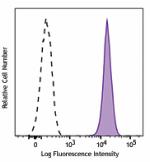
Human peripheral blood lymphocytes were stimulated with (fil... -
Brilliant Violet 421™ anti-ERK1/2 Phospho (Thr202/Tyr204)
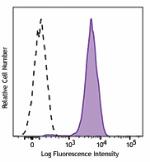
Human peripheral blood lymphocytes were stimulated with (fil... -
PerCP/Cyanine5.5 anti-ERK1/2 Phospho (Thr202/Tyr204)
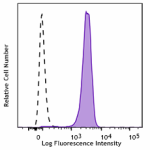
Human peripheral blood lymphocytes were stimulated with (fil... -
PE/Cyanine5 anti-ERK1/2 Phospho (Thr202/Tyr204)
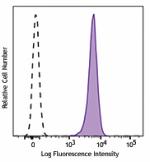
Human peripheral blood lymphocytes were stimulated with (fil... -
Purified anti-ERK1/2 Phospho (Thr202/Tyr204)
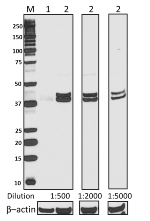
Total cell lysates (15 µg protein) from non-treated (lane 1)... 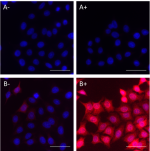
HeLa cells were treated with (+) or without (-) 100 ng/mL PF... -
FITC anti-ERK1/2 Phospho (Thr202/Tyr204)
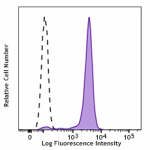
Human peripheral blood lymphocytes were stimulated with (fil... -
PE/Cyanine7 anti-ERK1/2 Phospho (Thr202/Tyr204)
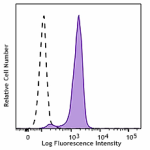
Human peripheral blood lymphocytes were stimulated with (fil... -
PE/Dazzle™ 594 anti-ERK1/2 Phospho (Thr202/Tyr204)

Human peripheral blood lymphocytes were stimulated with (fil... -
APC anti-ERK1/2 Phospho (Thr202/Tyr204)
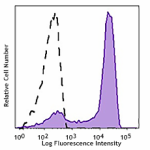
Human peripheral blood lymphocytes were stimulated with (fil...
 Login / Register
Login / Register 









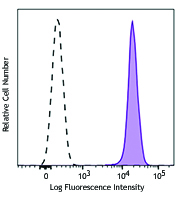

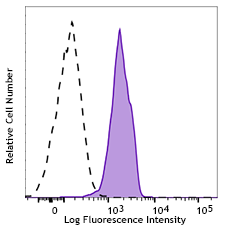




Follow Us